Why you can trust Tom's Hardware
Comparison Products
We tested the Extreme Pro v2 against its predecessor, the Extreme Pro v1, as well as a few of the best portable SSDs available. We threw in Samsung’s X5, LaCie’s Rugged SSD Pro, and Sabrent’s Rocket XTRM-Q 8TB as high-end Thunderbolt 3 alternatives, as well as a WD Black P50, another USB 20 Gbps contender. We also added the LaCie Rugged SSD, Samsung T7, and Crucial X8 as cheaper 10Gbps competitors.
Transfer Rates – DiskBench
DiskBench is a storage benchmarking tool that allows us to test the transfer or copy performance of a storage device with real data. We test external drives with three file transfers that consist of 25GB of photos (10GB of .jpg and 15GB of .RAW photos), 50GB of movies, and 25GB of documents. First, we transfer each folder from a 1TB NVMe SSD to the external device; then, we follow up by reading a 3.7GB 7-zip file and a 15GB movie back from the device.
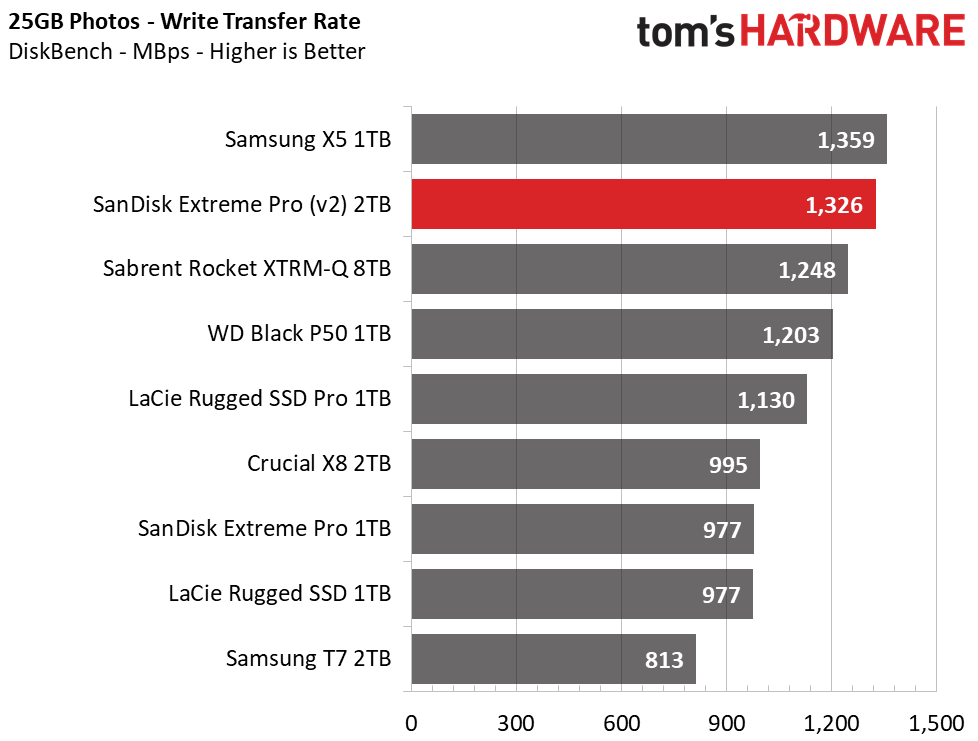
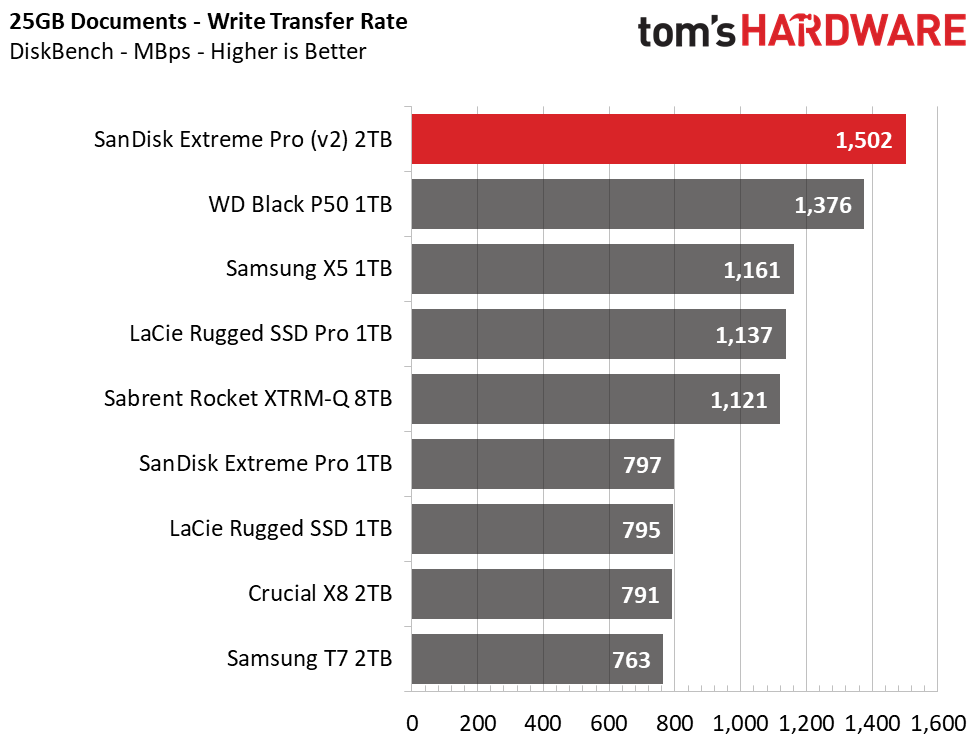
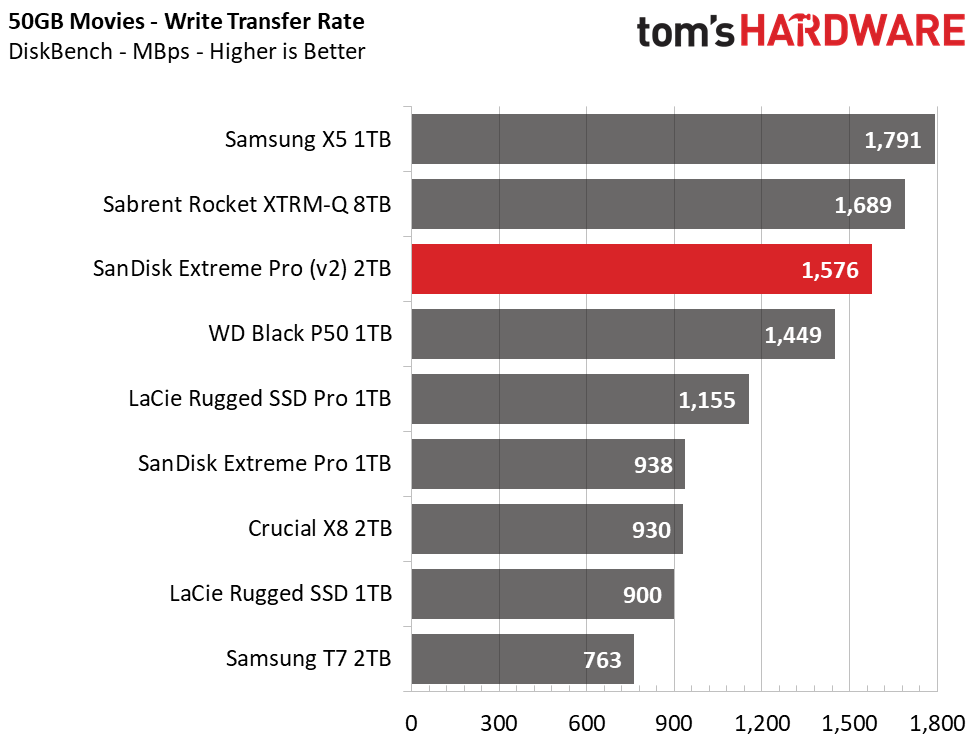
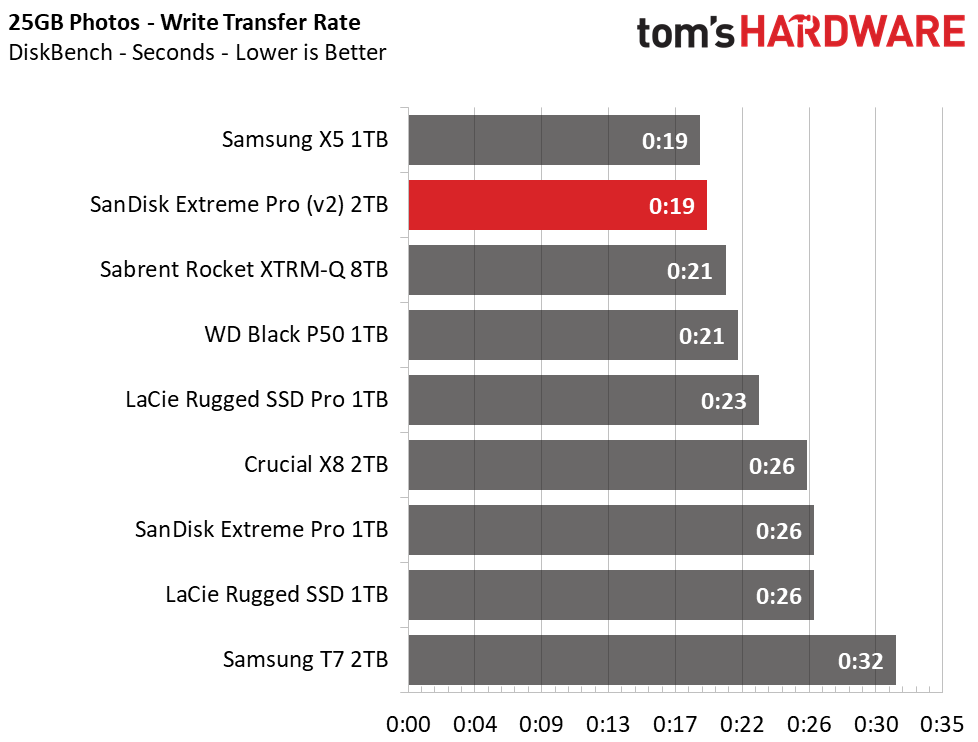
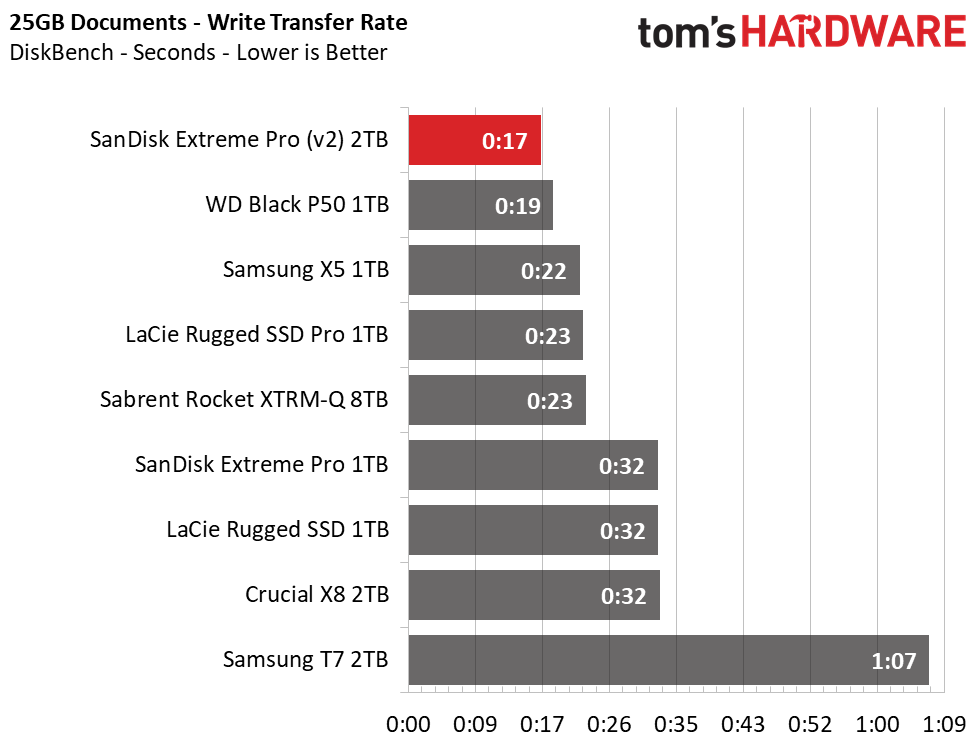
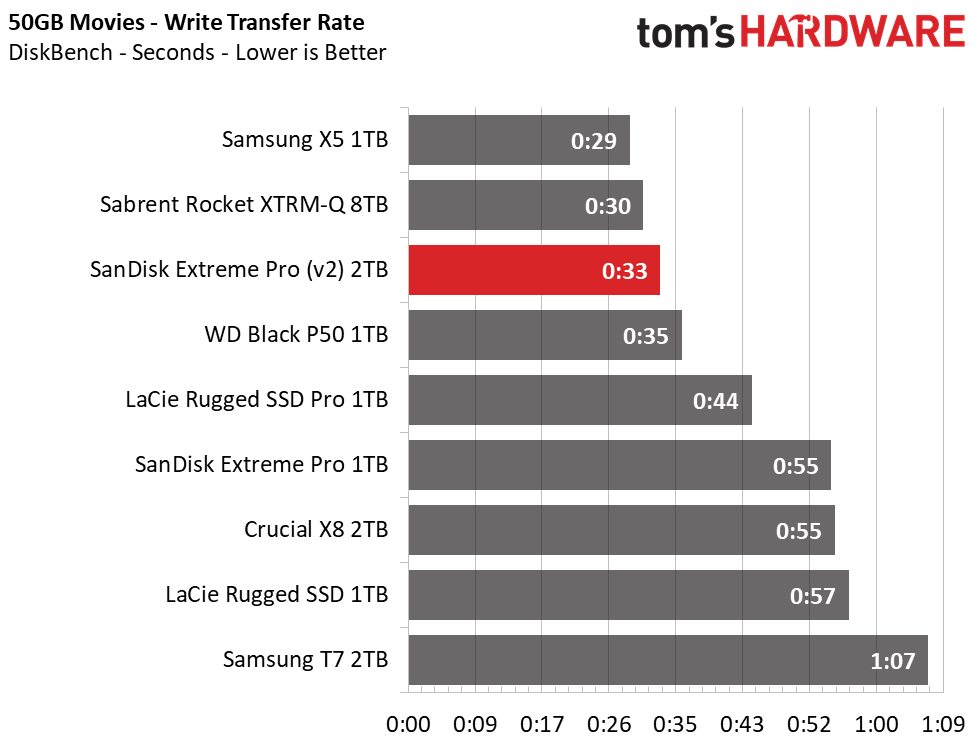
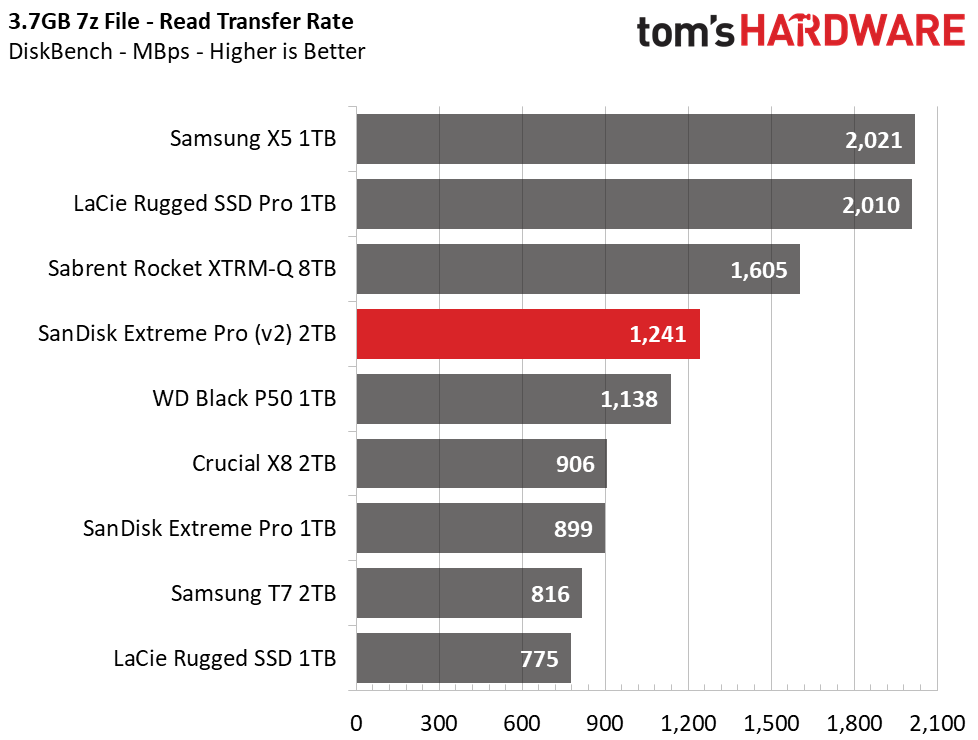
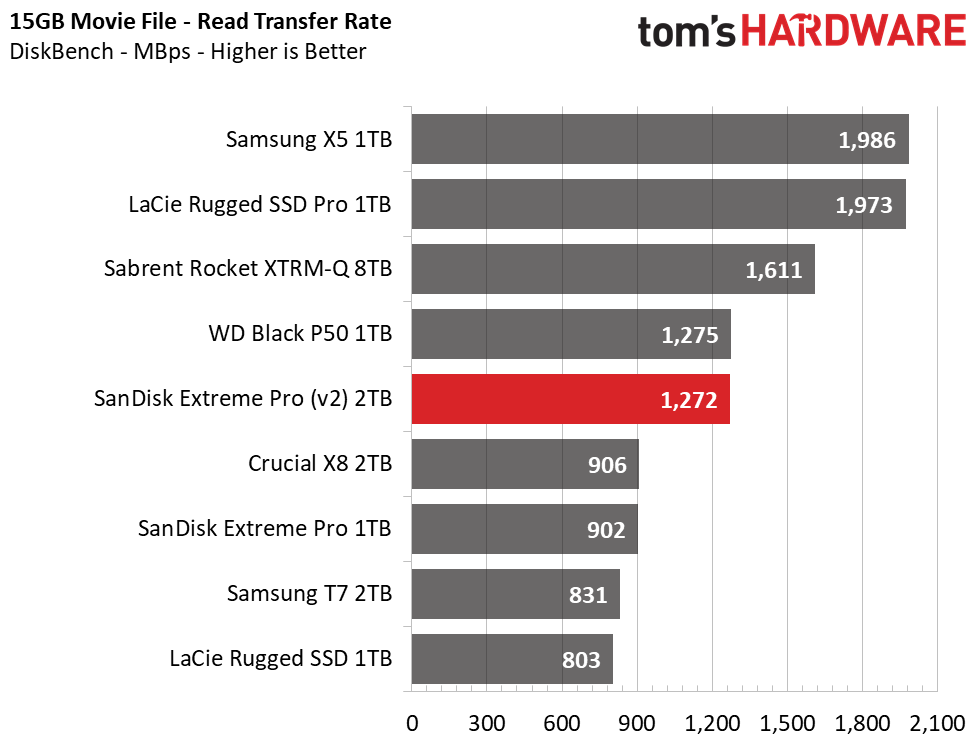
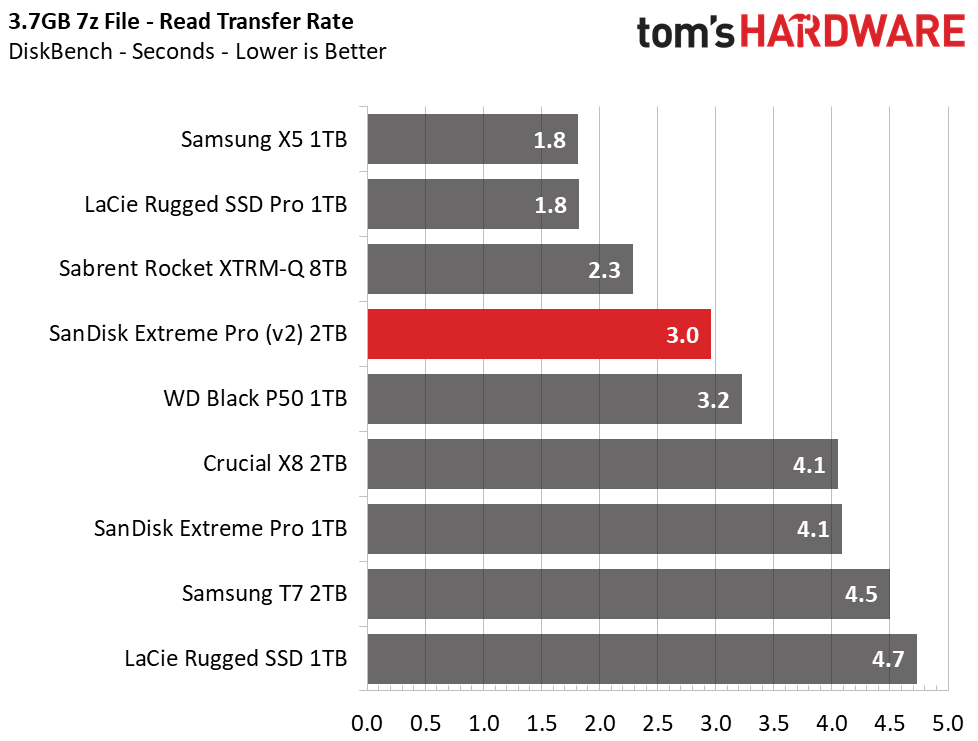
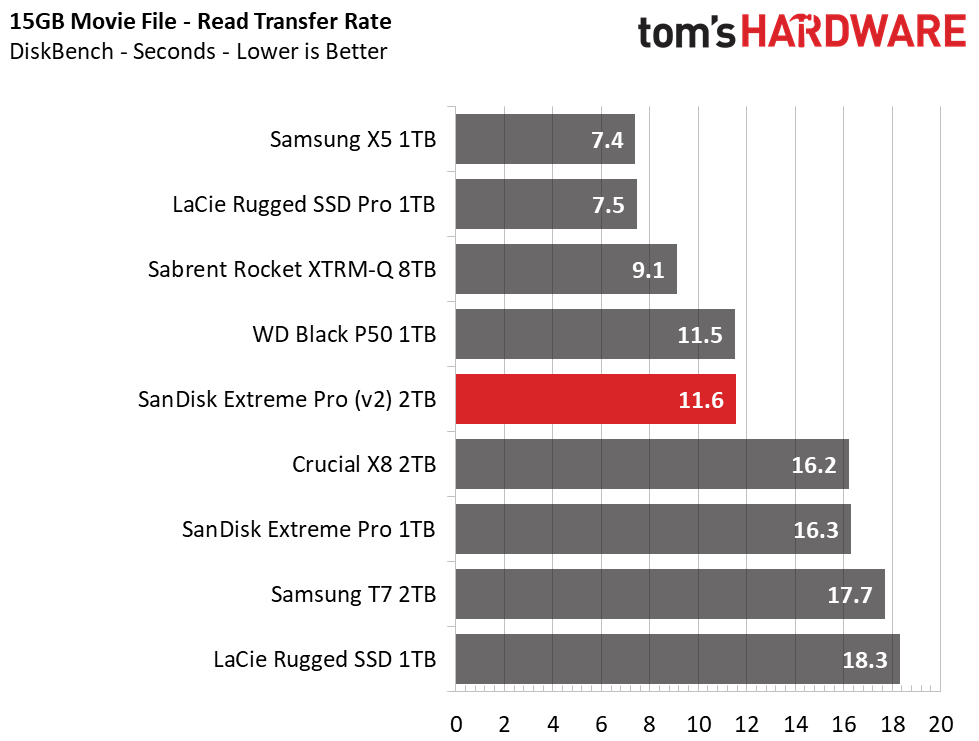
SanDisk’s Extreme Pro v2 delivers exceptional file copy and read performance. While the Thunderbolt 3 SSDs outperformed the Extreme Pro and the WD Black P50 in the large file transfer tests, they were outperformed during the 25GB documents transfer because the workload taxes them with writing small random files.
Trace Testing – PCMark 10 Storage Test: Data Drive Benchmark
PCMark 10 is a trace-based benchmark that uses a wide-ranging set of real-world traces from popular applications and common tasks to measure the performance of storage devices. To test drives that store files rather than applications, we utilize the Data Drive Benchmark.
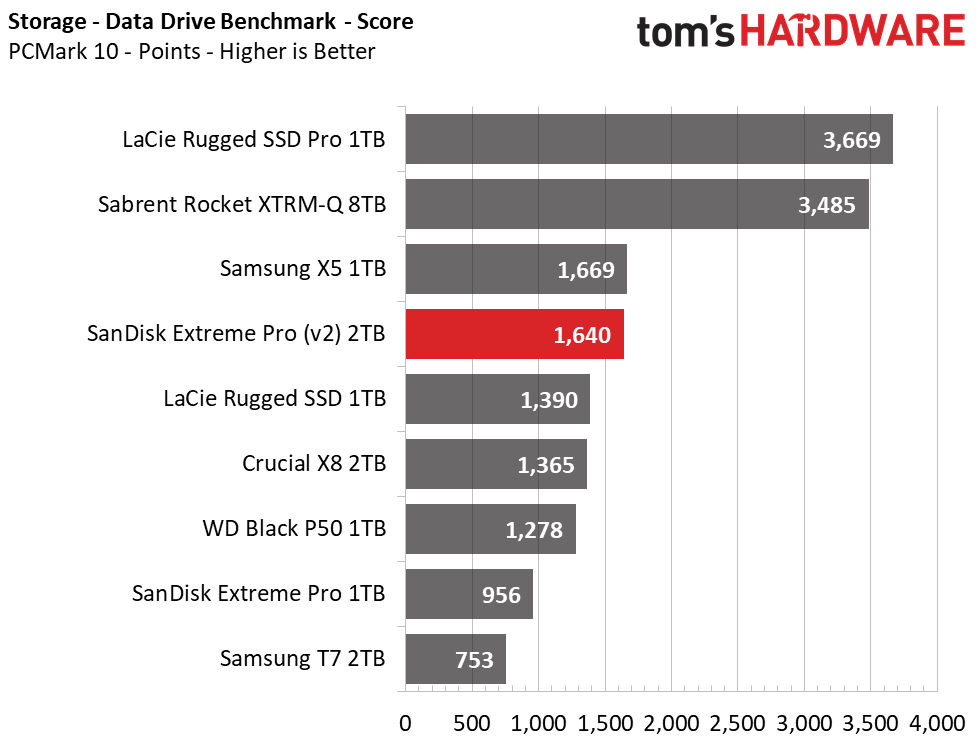
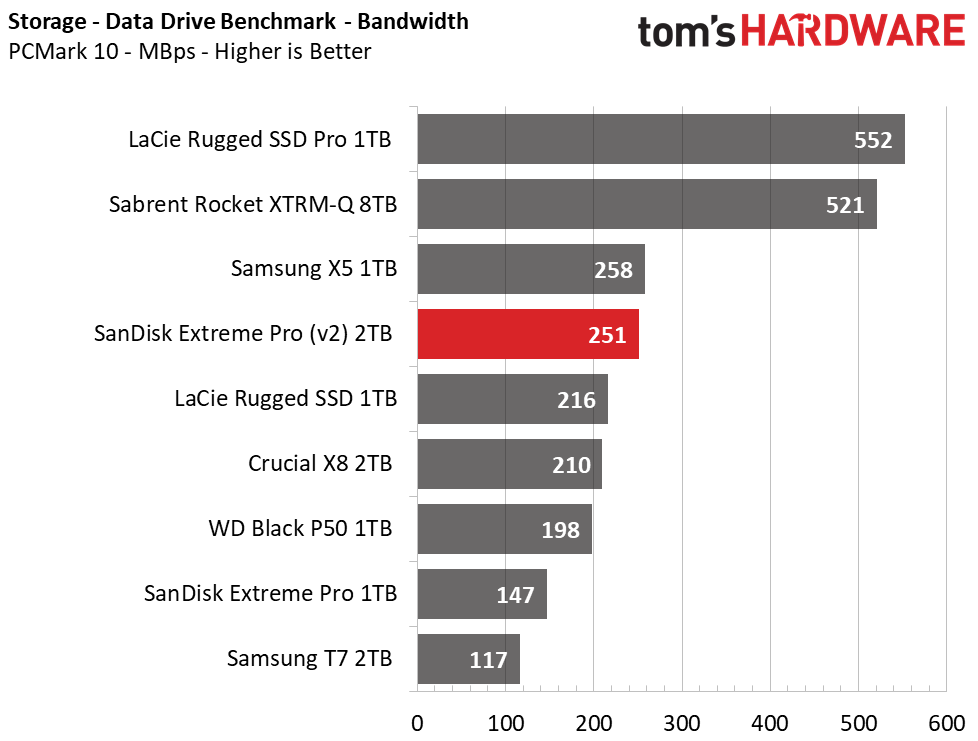
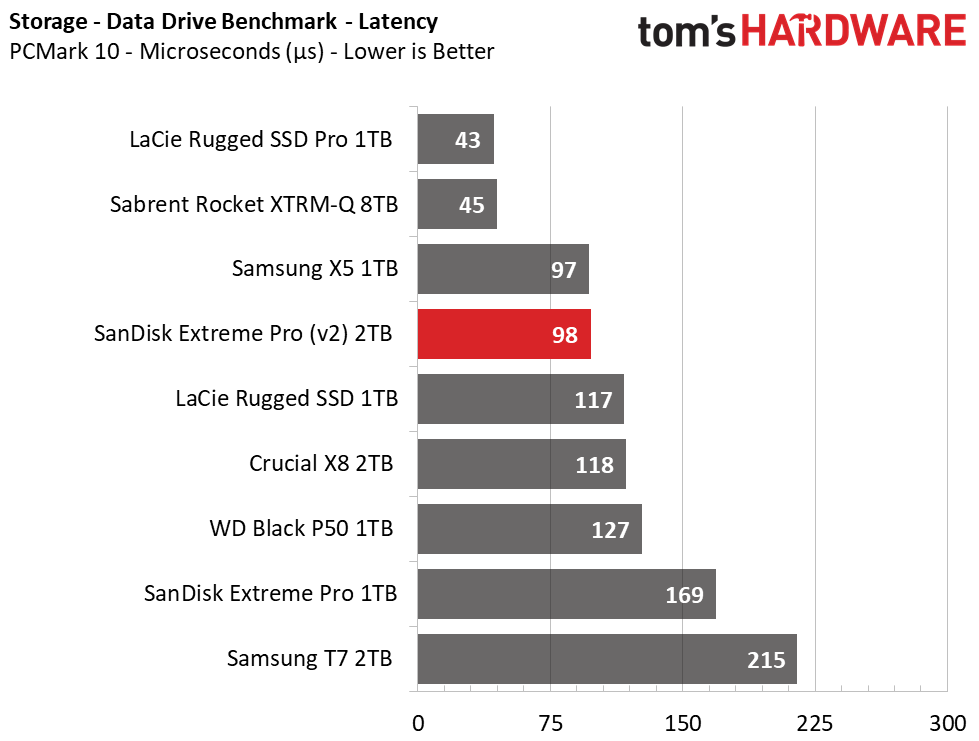
Scoring fourth place in PCMark 10’s data drive storage benchmark, SanDisk’s Extreme Pro v2 again delivers exceptional responsiveness for a portable SSD. We noted a remarkable improvement over its predecessor. The v2 is nearly on par with the Samsung X5, which easily surpassed the performance of its 10 Gbps competition.
Synthetic Testing - ATTO / iometer
iometer is an advanced and highly configurable storage benchmarking tool, while ATTO is a simple and free application that SSD vendors commonly use to assign sequential performance specifications to their products. Both of these tools give us insight into how the device handles different file sizes.

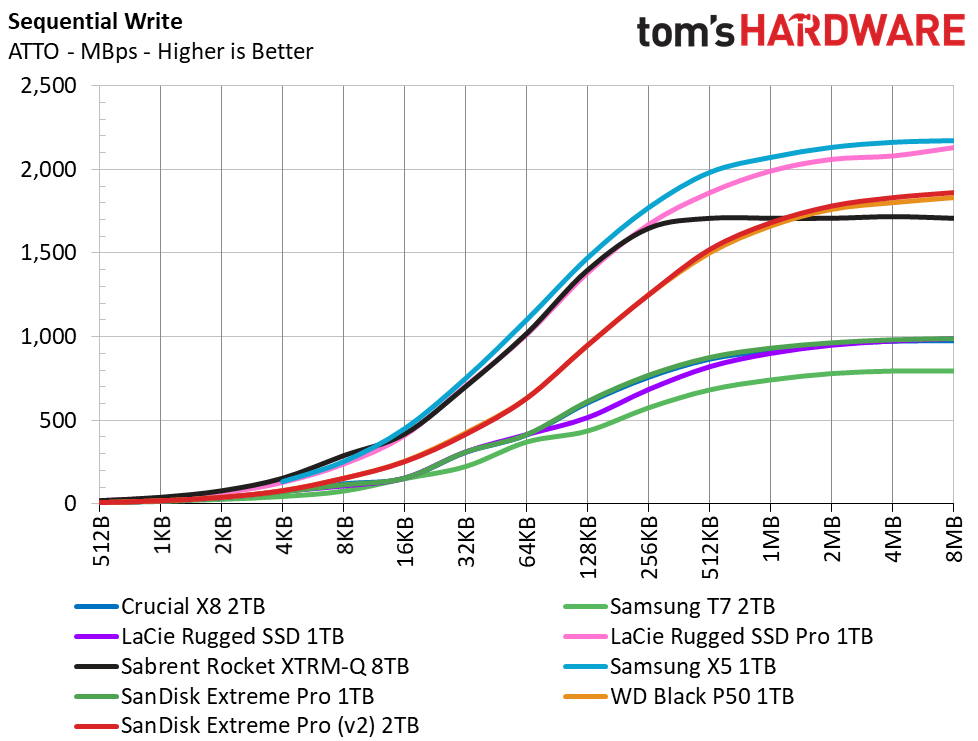
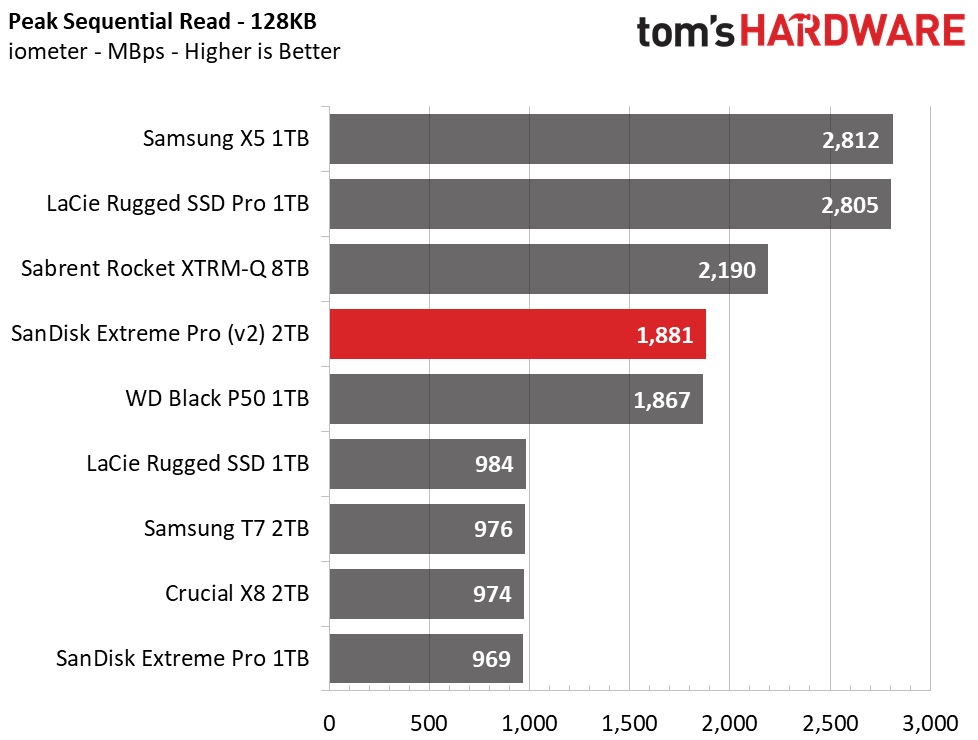
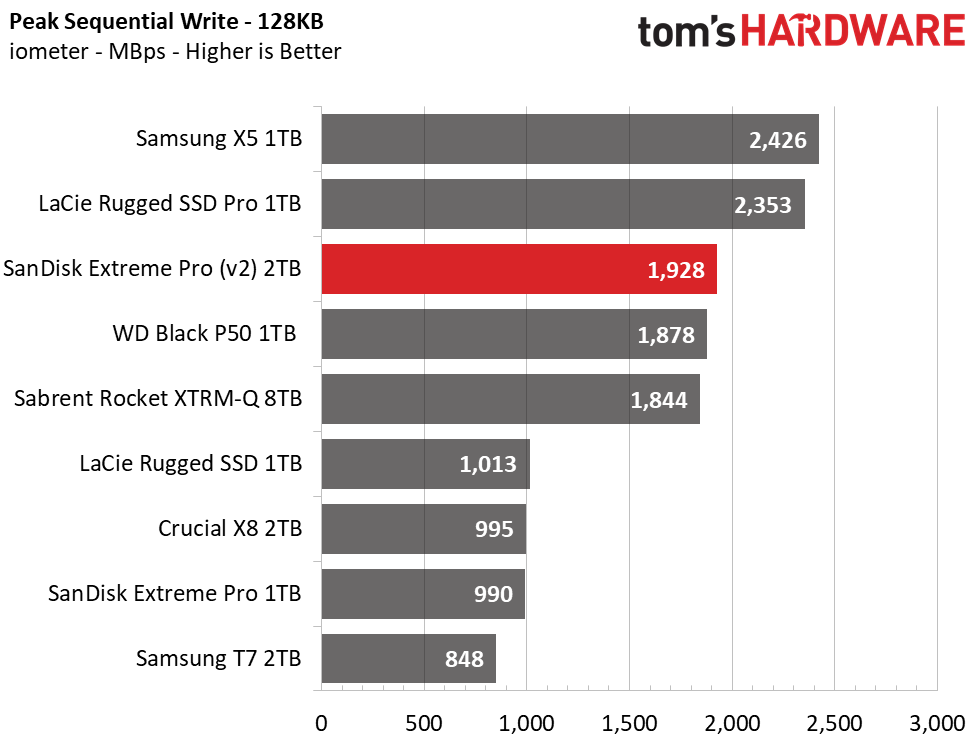
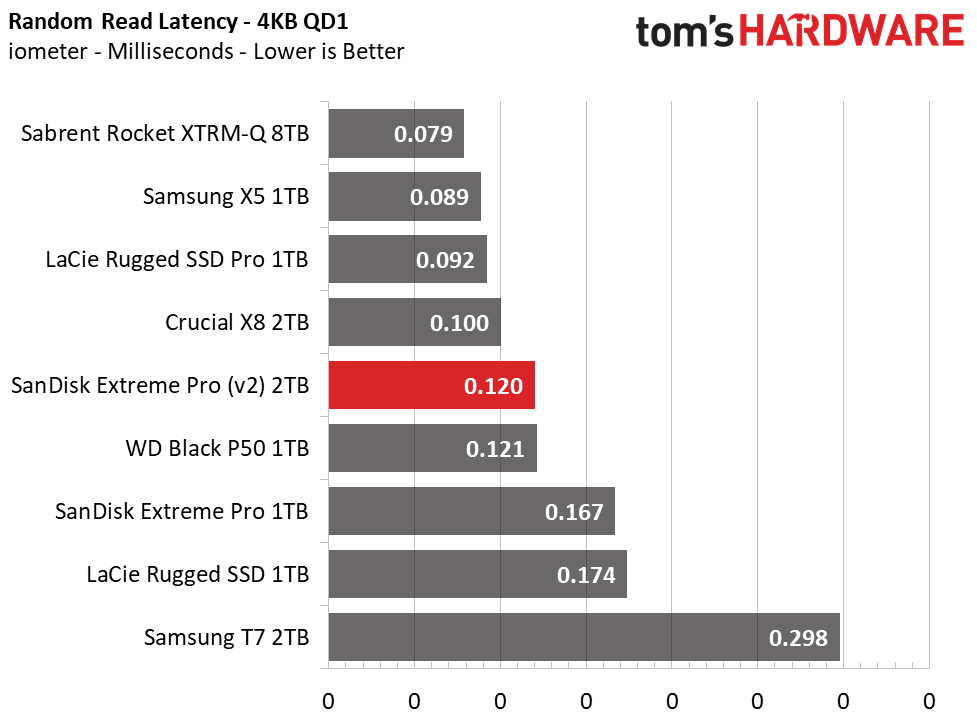
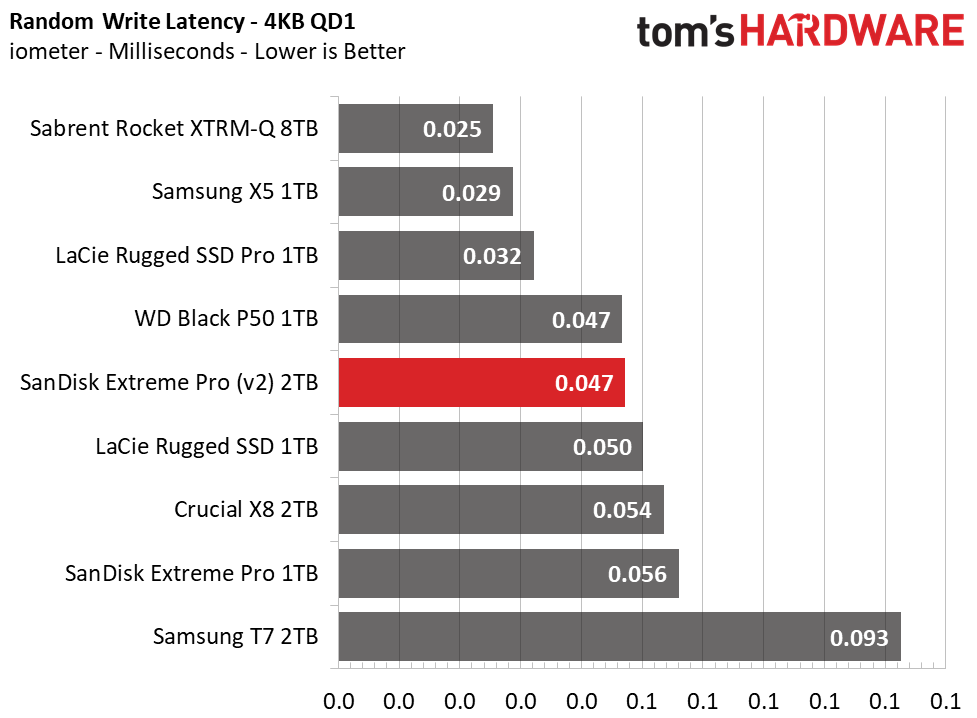
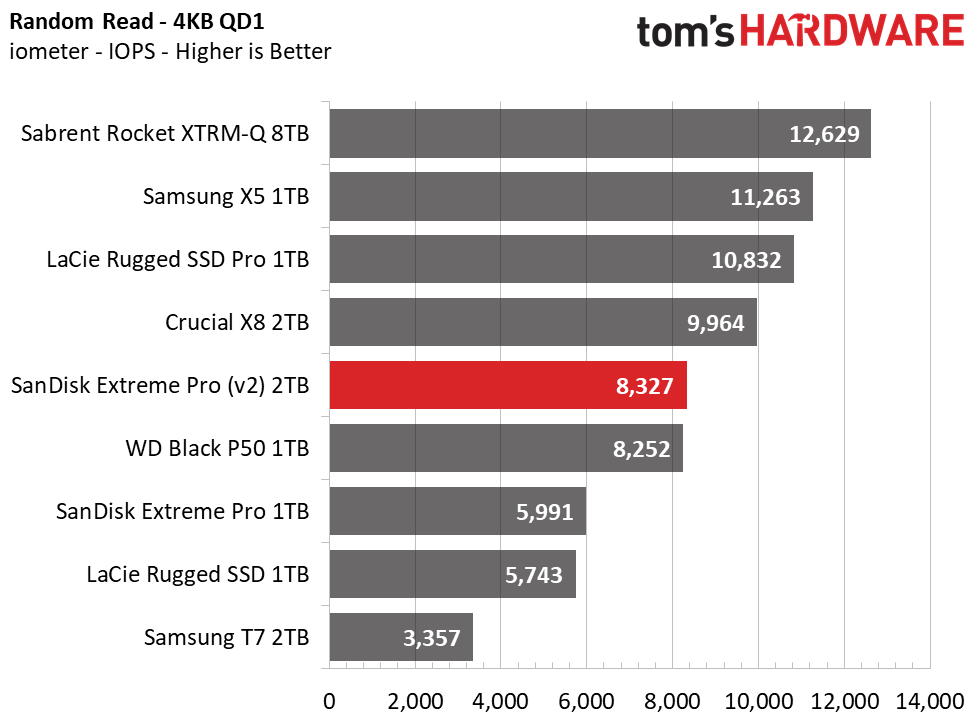
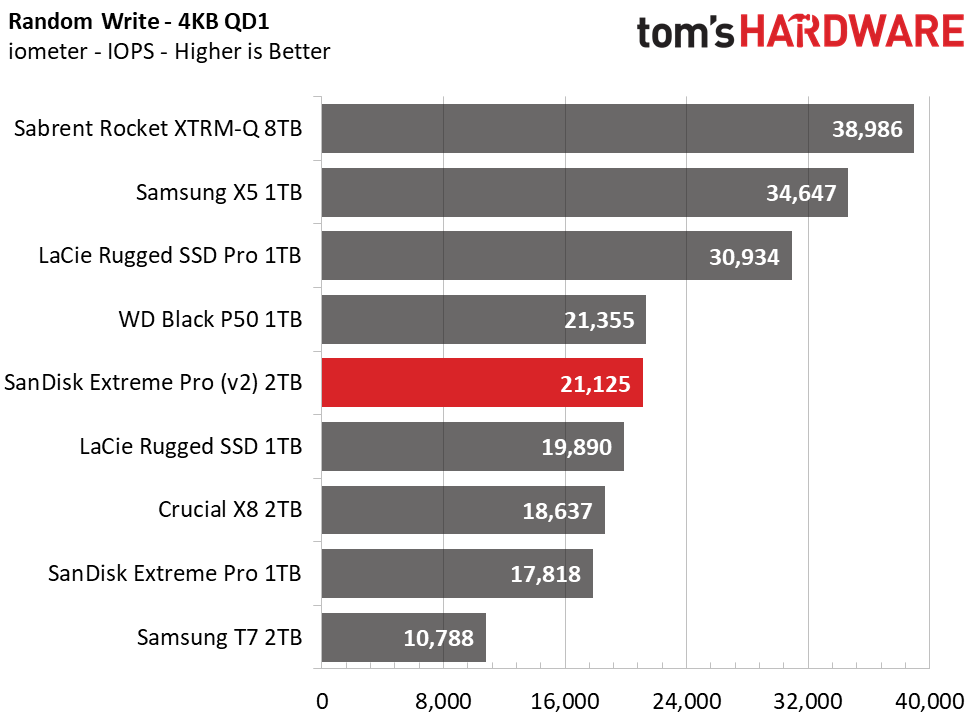
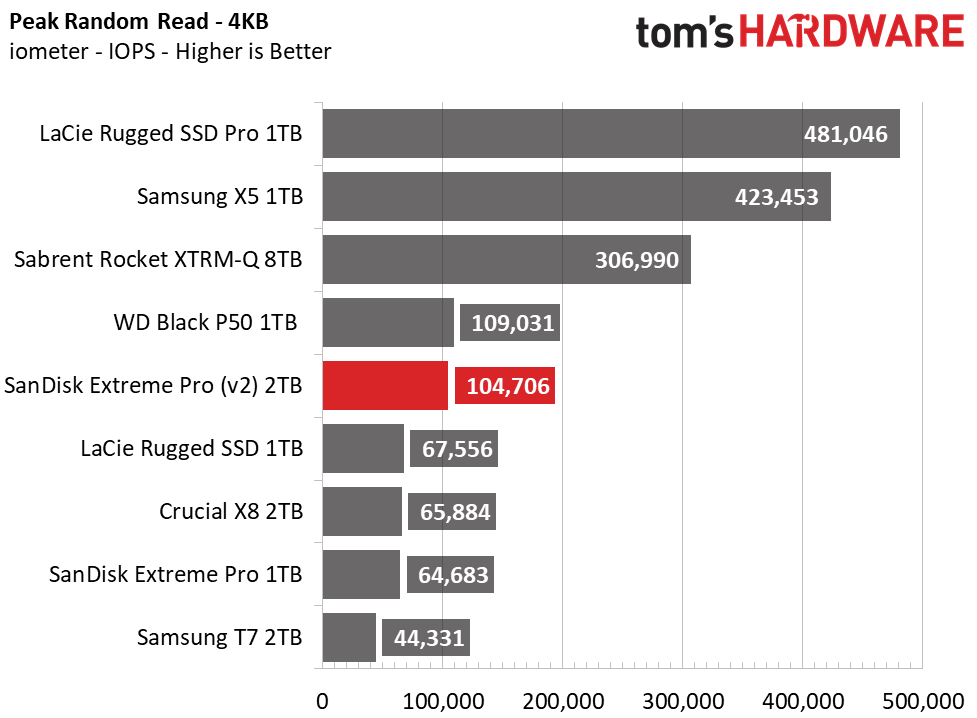
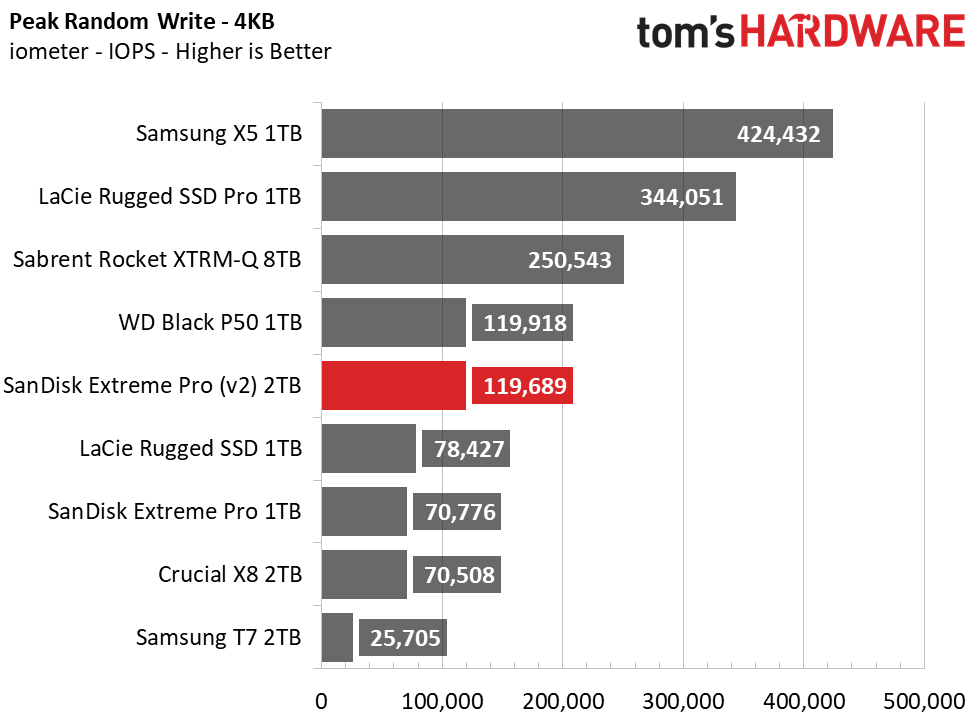
SanDisk’s Extreme Pro v2 displays very strong sequential read and write performance with notable gains at smaller file sizes compared to the older WD Black SN750-powered WD Black P50. The NVMe protocol aids the Thunderbolt 3 SSDs, so they tend to respond much faster across the board.
Get Tom's Hardware's best news and in-depth reviews, straight to your inbox.
Sustained Write Performance, Cache Recovery, and Temperature
Write speed and temperature are two important and inter-related metrics for external devices. Official write specifications are only part of the performance picture. Most SSDs implement a write cache, which is a fast area of (usually) pseudo-SLC programmed flash that absorbs incoming data. Sustained write speeds can suffer tremendously once the workload spills outside of the cache and into the "native" TLC or QLC flash. We use iometer to hammer the SSD with sequential writes for 15 minutes to measure both the size of the write cache and performance after the cache is saturated. We also monitor cache recovery via multiple idle rounds.
We also monitor the temperature of the drive via the S.M.A.R.T. data and an IR thermometer to see when (or if) thermal throttling kicks in and how it impacts performance. Bear in mind that results will vary based on the workload and ambient air temperature.
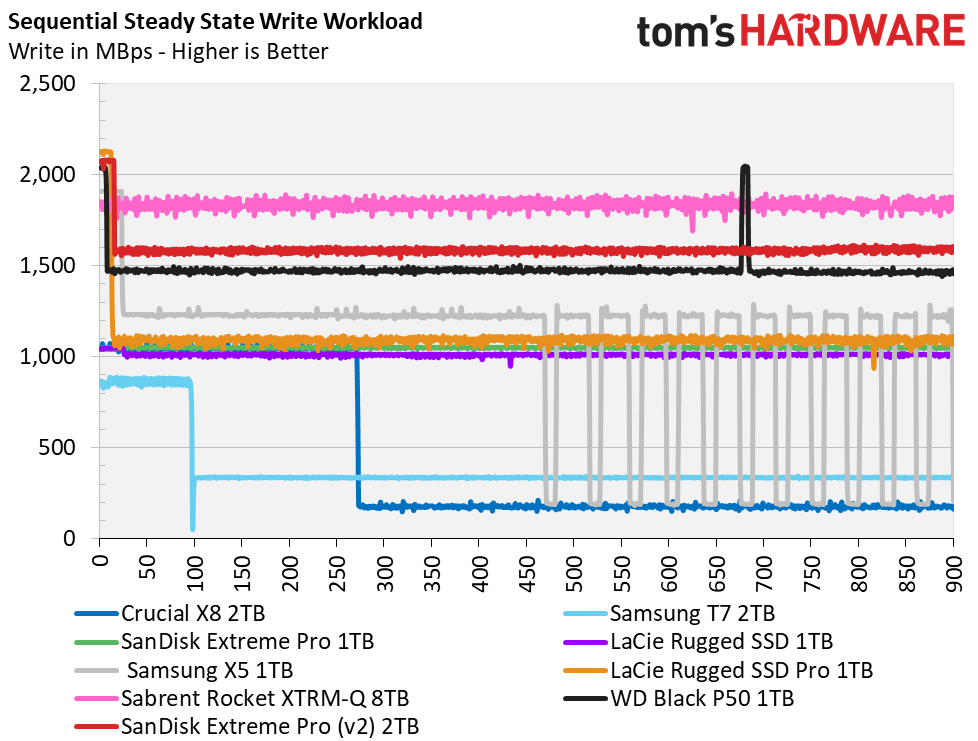
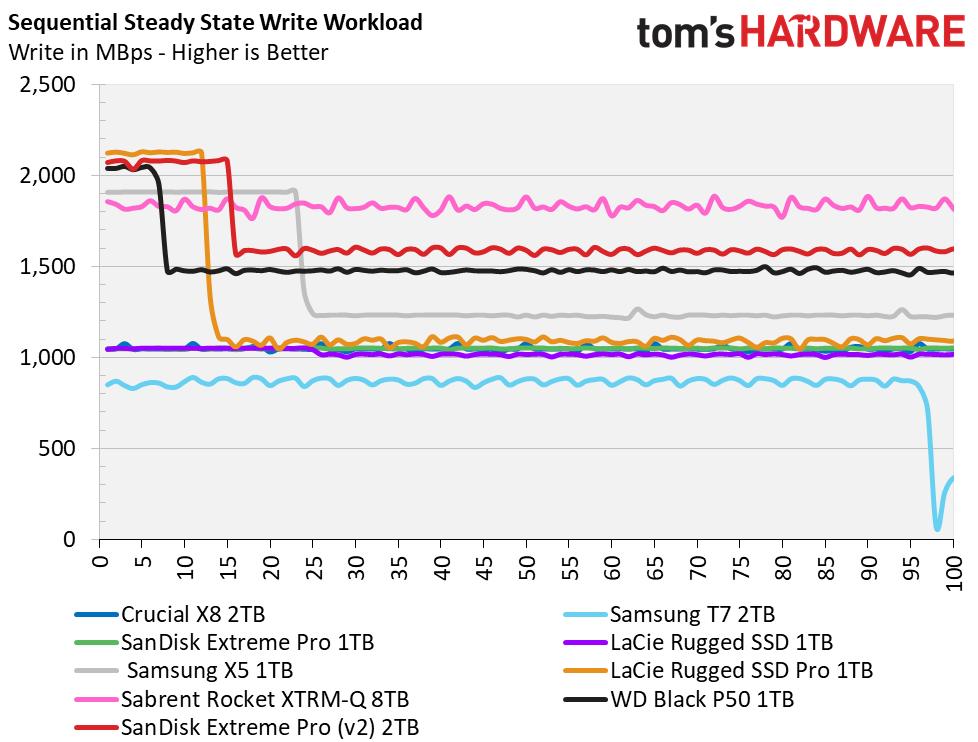
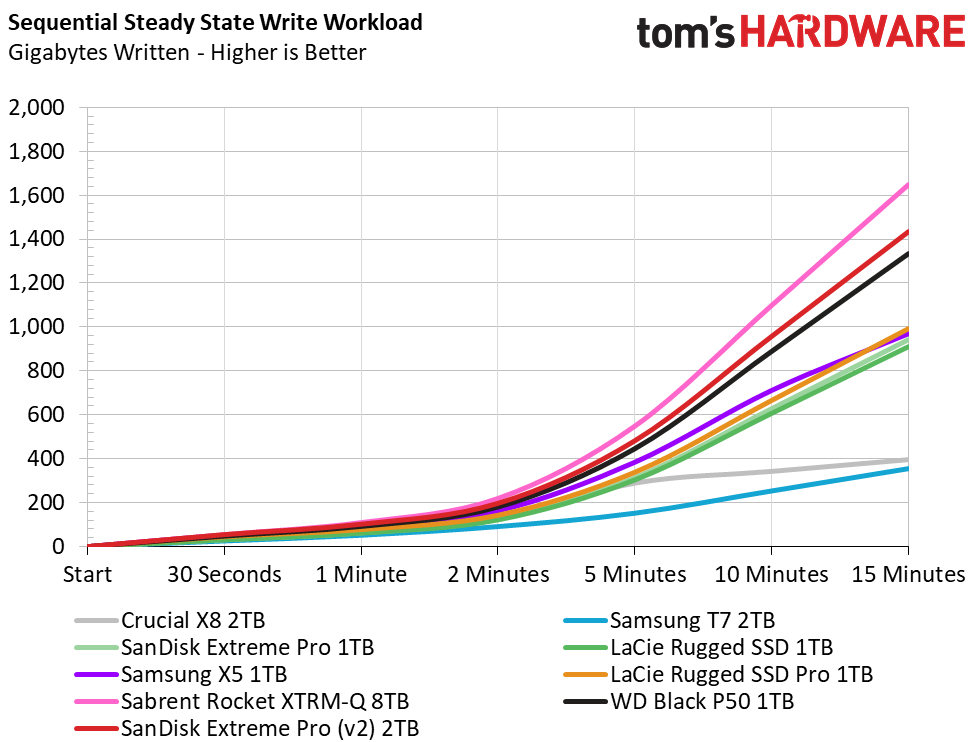
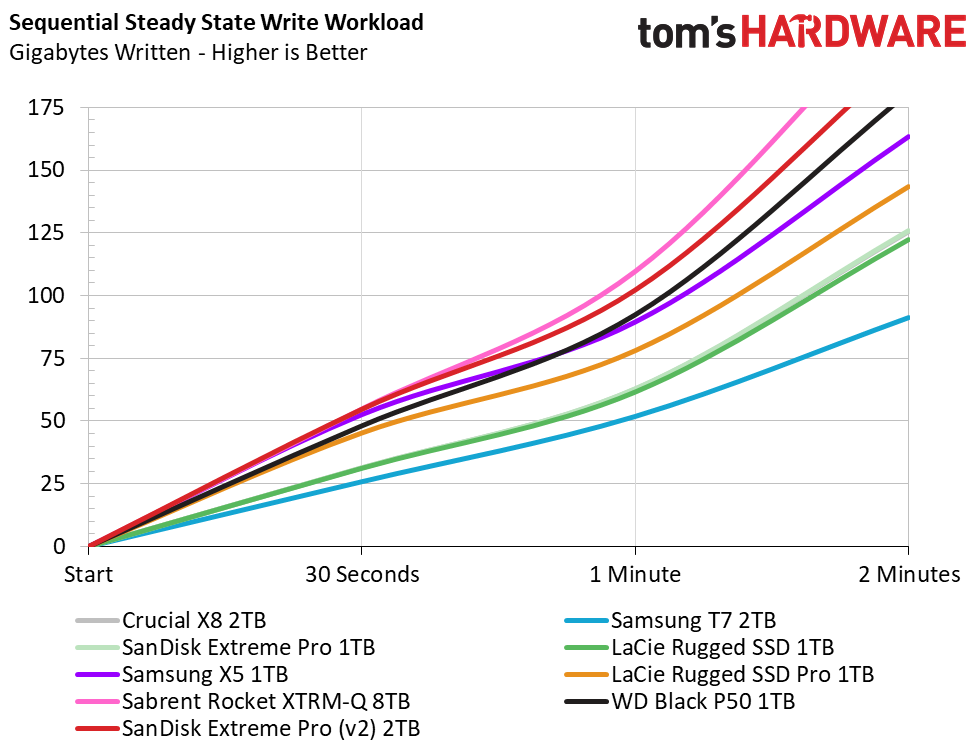
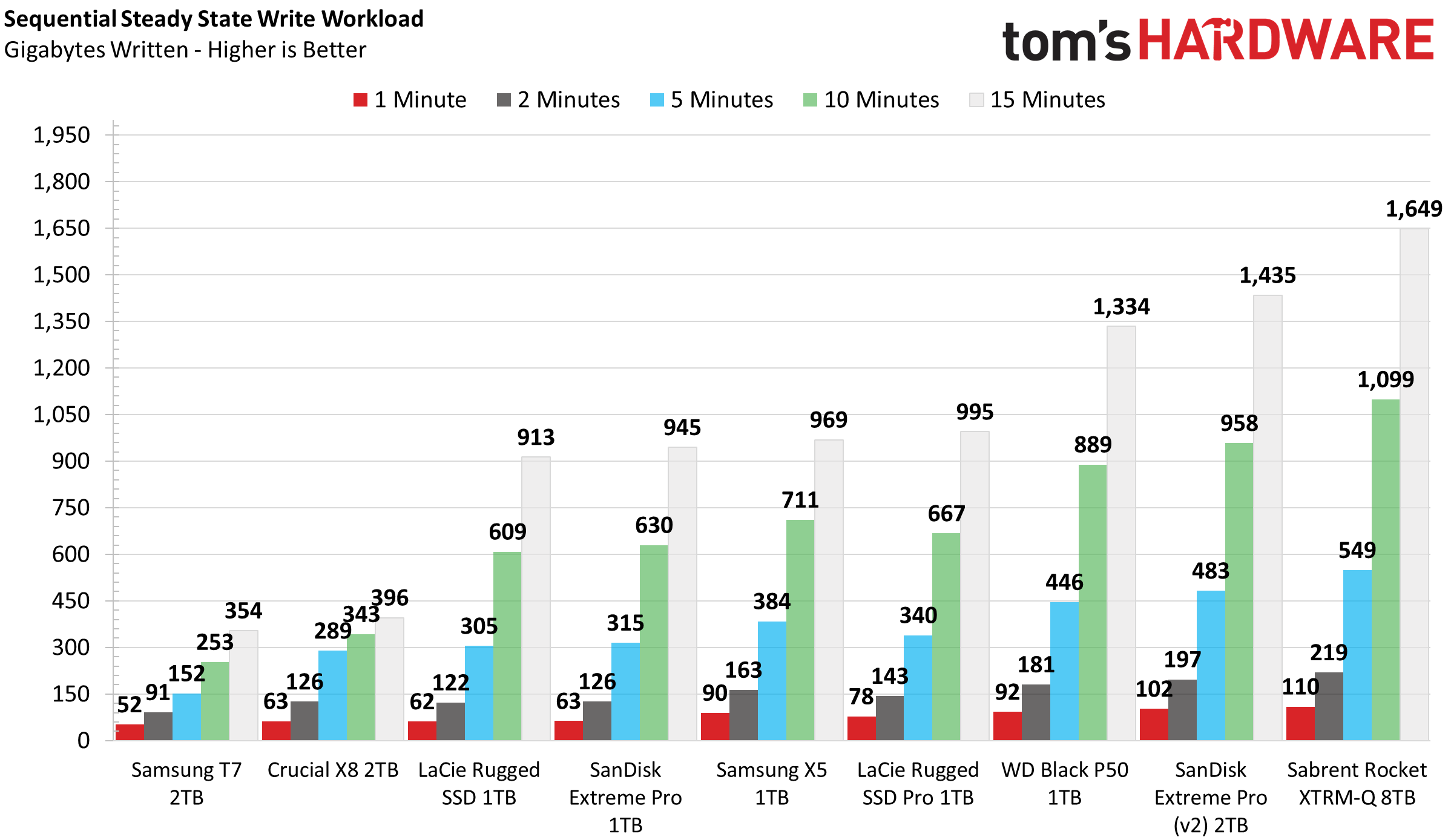
Second only to the super-expensive 8TB Sabrent Rocket XTRM-Q, SanDisk’s new 2TB Extreme Pro v2 boasts impressive write performance. The SSD wrote 32GB of data at a rate of roughly 2 GBps before degrading to a consistent direct-to-TLC performance of 1.6 GBps. After 30 seconds of idle time, the SanDisk Extreme Pro reclaimed the full capacity of its static SLC write cache.
SanDisk’s Extreme Pro v2 idles a little warm, with the surface of the device measuring 40 degrees Celsius when simply connected to the system, or roughly 6-10 degrees Celsius hotter than most 10Gbps devices. (The S.M.A.R.T. data reports a device temperature of 44 degrees Celsius.)
The performance never slowed due to throttling, even after writing 600GB of data to the devices. While the drive runs warm, it will deliver exceptional performance most of the time thanks to the chassis acting as a heatsink. Maximum temperatures hit roughly 48 degrees Celsius on the surface (S.M.A.R.T. data reported 58 degrees Celsius.)
MORE: Best SSDs
MORE: How We Test HDDs And SSDs
MORE: All SSD Content

Sean is a Contributing Editor at Tom’s Hardware US, covering storage hardware.
-
nofanneeded ReplyWith the USB 20 Gbps link, the drive even outperformed the Thunderbolt 3 competition under various workloads
This is not true , because the internal hardware of TB3 drives tested does not match ... If you want the best out of TB3 , you should get an empty TB3 box and put the best NVME SSD inside it.
Tomshardware needs to review this product
http://www.orico.cc/usmobile/product/detail/id/6861
Use it with fastest PCIe Gen 3.0 NVME SSD around. -
seanwebster Replynofanneeded said:This is not true , because the internal hardware of TB3 drives tested does not match ... If you want the best out of TB3 , you should get an empty TB3 box and put the best NVME SSD inside it.
Tomshardware needs to review this product
http://www.orico.cc/usmobile/product/detail/id/6861
Use it with fastest PCIe Gen 3.0 NVME SSD around.
At that point you wouldn't be testing the actual portable SSDs as they are, you would just be testing the performance of the internal SSDs in that one enclosure. Thus, comparing just the underlying storage alone. You can't compare the performance or thermal characteristics of these portable SSDs without using the default enclosures and bridge chips.
I have tested the internal M.2 SSDs by themselves on an X570 platform, you can read my reviews on them if you are interested.
Also, that enclosure is made with an older Alpine Ridge TB3 controller, not titan ridge or newer like on some of these portable SSDs. So, its older tech. -
nofanneeded Replyseanwebster said:At that point you wouldn't be testing the actual portable SSDs as they are, you would just be testing the performance of the internal SSDs in that one enclosure. Thus, comparing just the underlying storage alone. You can't compare the performance or thermal characteristics of these portable SSDs without using the default enclosures and bridge chips.
I have tested the internal M.2 SSDs by themselves on an X570 platform, you can read my reviews on them if you are interested.
Also, that enclosure is made with an older Alpine Ridge TB3 controller, not titan ridge or newer like on some of these portable SSDs. So, its older tech.
TB3 is more popular then USB 3.2 2x2 which is impossible to find in notebook and very rare in Desktops.
Can you please gather the best NVME external boxes in the market and test them with something like Samsung 970 Evo Plus or 970 pro ? make a round up ? and see if they reach 3000MB/s ???
Because all portable SSD are a box with internal off the shelves NVME SSD .. I am 100% sure you will find the same Version of SANDISK Extreme Pro as a stand alone NVME ...
Also you need to tear down the External drives in each review to see which NVME SSD is in there ... it will also help you to determine TBW/IOPS if the external drive does not say just by discovering which NVME SSD they are using inside. -
seanwebster Reply
I review all kinds of SSDs, including TB3 and USB of all types. I'll look into it. Is there anything specific you are looking for?nofanneeded said:TB3 is more popular then USB 3.2 2x2 which is impossible to find in notebook and very rare in Desktops.
Can you please gather the best NVME external boxes in the market and test them with something like Samsung 970 Evo Plus or 970 pro ? make a round up ? and see if they reach 3000MB/s ???
Yes, most are just M.2s in an enclosure. It's hard to or impossible to open some of these without destroying them, which I try best to avoid. This drive is powered by a WD SN730E, as mentioned in the review, so I already know the specs inside and out. The WD Black P50 uses the SN750E. The cheaper WD My Passport SSD and SanDisk Extreme have WD's Blue SN550E inside them, too. You can read my reviews on those to learn more if you like.nofanneeded said:Because all portable SSD are a box with internal off the shelves NVME SSD .. I am 100% sure you will find the same Version of SANDISK Extreme Pro as a stand alone NVME ...
Also you need to tear down the External drives in each review to see which NVME SSD is in there ... it will also help you to determine TBW/IOPS if the external drive does not say just by discovering which NVME SSD they are using inside.
WD Black SN750: https://www.tomshardware.com/reviews/wd-black-sn750-ssd,5957.htmlWD Blue SN550: https://www.tomshardware.com/reviews/wd-blue-sn550-m2-nvme-ssd-review-best-dramless-ssd-yet
I have rarely seen a company include that metric for a portable SSD. Typically, they are just warrantied by time alone. Also, most endurance ratings are conservative, but yes, you can get an estimate of expected endurance by understanding which SSD is powering the device. It's just that TBW warranty coverage restrictions do not apply to most portables.
As for IOPS - what is the point of testing the device outside of its designed enclosure if it is forever going to be used in the enclosure? I can test portable SSDs' IOPS perfectly fine as they come. They are not going to be used as internal SSDs, only as portables. So, comparing the performance without the bridge chip they come with is irrelevant. And again, I've already reviewed the internal devices as linked above. ;) -
nofanneeded Replyseanwebster said:I review all kinds of SSDs, including TB3 and USB of all types. I'll look into it. Is there anything specific you are looking for?
Thunderbolt 3 enclosures round up ... with the fastest NVMe SSD (>3000MB/s) inside to see the real potential of the enclosure .. -
Practicerts Is it worth buying now that it has had a price decrease?Reply
The 1TB is now $119.99
The 2TB is now $219.99 -
NedSmelly Reply
No. Avoid at all costs.Practicerts said:Is it worth buying now that it has had a price decrease?
The 1TB is now $119.99
The 2TB is now $219.99
https://www.tomshardware.com/news/sandisk-extreme-pro-failures-are-due-to-design-flaw
https://www.tomshardware.com/news/wd-faces-class-action-lawsuit-over-sandisk-extreme-pro-ssd-failures -
Order 66 Reply
I was going to say go buy a 980 pro, but it seems that has gone up as well. I think I bought it at $119, and now it's at $169. Even at $169, it's still better even ignoring the drive failures.Practicerts said:Is it worth buying now that it has had a price decrease?
The 1TB is now $119.99
The 2TB is now $219.99